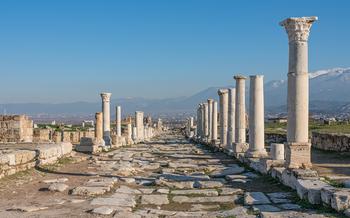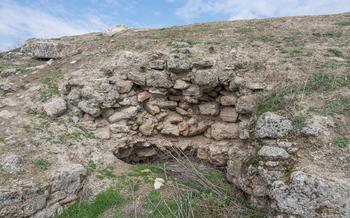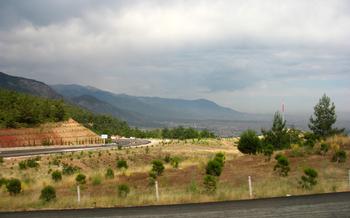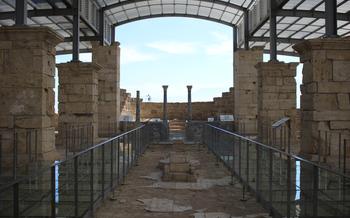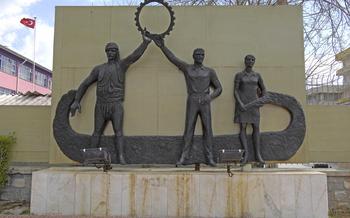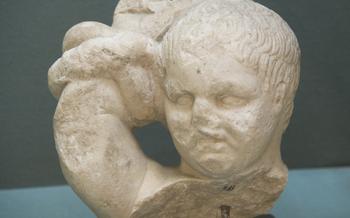
Agora Open Air Museum
- Denizli's Antiquity
- Laodicea on the Lycus: A City of Antiquity
- The New Museum: A Home for Denizli’s Treasures
Denizli's Antiquity
A Land Steeped in History: Denizli, a captivating city in southwestern Turkey, boasts a rich and storied past that dates back to antiquity. Its ancient heritage is deeply intertwined with the rise and fall of civilizations, each leaving an indelible mark on its landscape and culture.
During the Hellenistic period, Denizli flourished as a major center of trade and culture, drawing influences from both Greek and Persian civilizations. The city's strategic location at the crossroads of important trade routes made it a hub for merchants and travelers from across the region. This vibrant cosmopolitan atmosphere fostered an exchange of ideas and artistic expression, contributing to the development of a unique blend of Hellenistic and Anatolian culture.
The arrival of the Romans in the 2nd century BC ushered in a new era of prosperity for Denizli. The city became part of the Roman province of Asia and served as a significant administrative and commercial center. The Romans constructed impressive infrastructure projects, including roads, aqueducts, and temples, transforming Denizli into a thriving metropolis. The city's strategic importance continued to grow as it became a key stopover on the trade route connecting Ephesus to the eastern provinces of the Roman Empire.
Denizli's position as a cultural and economic hub during the Roman era attracted a diverse population, including Greeks, Romans, and Jews. This melting pot of cultures gave rise to a vibrant and cosmopolitan society, reflected in the city's architecture, art, and religious practices. The construction of monumental structures such as the Hierapolis amphitheater and the Laodicea aqueduct showcased the city's wealth and grandeur.
Laodicea on the Lycus: A City of Antiquity
Laodicea on the Lycus, one of Denizli's most prominent ancient cities, flourished during the Roman era. Established by the Seleucid Greek king Antiochus II Theos in the 3rd century BC, the city was strategically situated along the Lycus River, a tributary of the Maeander River. Its location facilitated trade and commerce, contributing to its economic prosperity.
During the Roman Empire, Laodicea on the Lycus gained significant importance. The city became part of the Roman province of Asia and served as a major trading hub. Its wealth and influence are reflected in the impressive ruins that remain today, including a well-preserved theater, a stadium, a gymnasium, and a nymphaeum.
The city's prosperity was closely tied to its textile industry. Laodicea on the Lycus was renowned for producing high-quality wool and garments, which were exported throughout the Roman Empire. The city's wealth also allowed for the construction of magnificent public buildings, such as temples, baths, and libraries.
In the 6th century AD, a devastating earthquake struck Laodicea on the Lycus, causing significant damage to the city. While the city was rebuilt, it never fully regained its former glory. Over time, Laodicea on the Lycus was abandoned, and its ruins were gradually covered by soil and vegetation.
Today, the ancient city of Laodicea on the Lycus is a fascinating archaeological site that offers a glimpse into the grandeur of the Roman Empire. Visitors can explore the well-preserved ruins, including the theater, stadium, and gymnasium, and imagine the bustling activity that once took place here. Laodicea on the Lycus stands as a testament to the rich cultural heritage of Denizli and the enduring legacy of the Roman Empire.
The New Museum: A Home for Denizli’s Treasures
The New Museum, a state-of-the-art facility, is a testament to Denizli’s commitment to preserving its rich cultural heritage. Inaugurated in 2018, the museum is a treasure trove of archaeological wonders, housing a vast collection of artifacts excavated from the ancient city of Laodicea.
Visitors are greeted by an impressive array of exhibits, including intricate mosaics, well-preserved sculptures, and everyday objects that provide a glimpse into the daily lives of Laodicea's inhabitants. The museum's curators have skillfully arranged the artifacts to tell the story of the city's history, from its humble beginnings to its rise as a prominent trading center.
Among the highlights of the New Museum are the stunning mosaics that once adorned the floors of Laodicea’s public buildings and private homes. These intricate artworks depict scenes from mythology, nature, and daily life, offering a vivid glimpse into the artistic traditions of the ancient world. Visitors can also admire a collection of marble sculptures, including statues of gods, goddesses, and emperors, which provide a testament to the city's skilled artisans.
The New Museum is not just a repository of ancient artifacts; it is also a dynamic center for research and education. The museum's curators regularly organize exhibitions, lectures, and workshops to promote the study of Denizli's rich cultural heritage. The museum also boasts a well-equipped library and research facilities, making it a valuable resource for scholars and students alike.
With its impressive collection of artifacts, interactive exhibits, and commitment to education, the New Museum is a must-visit destination for anyone interested in exploring the rich history of Laodicea and the surrounding region.
